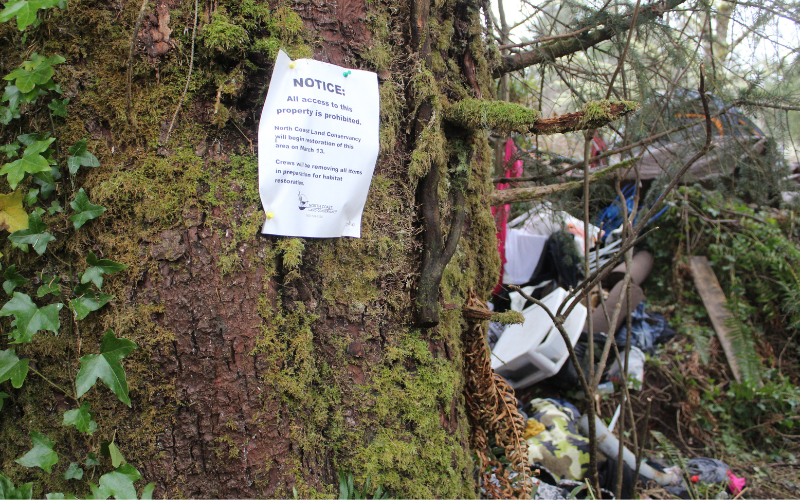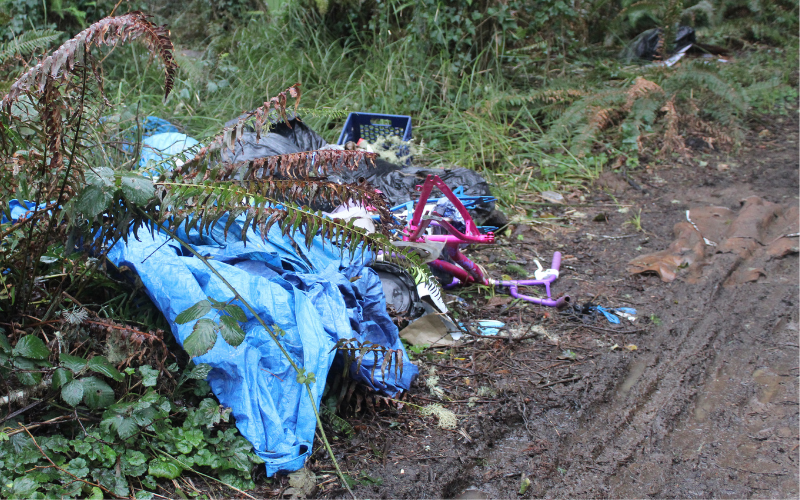In March, we began a new cleanup and restoration project at our Shangrila Wetland Habitat Reserve, which is located on the south end of Seaside near the Mill Ponds.
Our project started with a largescale cleanup March 15 to 17. We contracted with a company to conduct this cleanup, as it was far too much work for us to handle internally and too risky to ask of volunteers.
Then, on Wednesday, March 22, we held a work party, our Shrub Shindig at Shangrila, to plant about 550 potted shrubs and additional willow tree whips. Our event was held in partnership with the Necanicum Watershed Council.

This is the latest step in our ongoing effort to thoughtfully care for this 70-acre land, which was conserved in 2009. Shangrila Wetland lies near the top of the Necanicum estuary and contains intertidal salt marsh, tidally influenced freshwater wetlands, freshwater marsh, and 50 acres of mature Sitka spruce. It is home to a great diversity of wildlife, from coho salmon and red-legged frogs to hummingbirds, willow flycatchers, and bald eagles.
A Community Crisis
We are at a crossroads with this property, and have been for a while. As some people in our community are undoubtedly aware, a section of this land—along with the adjacent Seaside Mill Ponds—has been increasingly impacted by human use in the past few years. These impacts are exacerbated by the worsening housing crisis confronting our community, our state, and our nation.
When we go out to monitor this property, we find a wide range of items scattered among the forest, ground into the soil, and tangled in the vegetation. Trash. Mattresses. Household décor. Books. Toys. Needles. Food packages. It is a constant reminder that this hardship knows no bounds when it comes to age, gender, personality, or past. The people without homes who have sought refuge wherever they can are as diverse as our community itself. A microcosm of humanity as a whole.
Houselessness in our community is a nuanced and complicated challenge that no single organization or sector can solve alone. We all need to step up—as individual community members, businesses and agencies—and actively participate in deriving a sustainable solution. While our normal work is conserving lands on the Oregon Coast, we have unique skills from this work that we can offer to participate in confronting this community crisis—whether that be working with Clatsop County and other municipalities to find and help acquire the right land on which to establish housing; exploring funding options; or advocating for a multi-pronged approach to serve those in our community who are vulnerable to houselessness.
When we think about the ways that we as a land trust might be able to help provide solutions to the houseless crisis, we do not think it should include allowing people to live on properties that have been conserved for sensitive habitat. This type of use is harmful to both the land and to people living there. During the winter, late fall, and early spring, the property experiences intense flooding. It is cold, wet and muddy. There was a reported death at the Mill Ponds this past winter, as well as various other medical incidents.
In addition, many of our habitat reserves possess added restrictions that come from the funding source used to help buy the land. Shangrila is an example of this and contains a conservation easement held by the state of Oregon. Restrictions include no construction, no development, no cutting of vegetation, no dumping, and prohibition of all access that negatively impacts conservation values, such as camping.
We have spent years deliberating how to approach this challenge in a way that is beneficial to both the land and the people who are attempting to live there, and we’ve taken steps to address it. We’ve put up “No Trespassing” signs. We’ve talked with individuals directly when monitoring the reserve. We’ve distributed information about resources for our homeless community that are available in the county. We’ve gone out with Seaside’s Community Service Officer to encourage people to relocate to the city’s designated campsite.
We have implemented these solutions to support our local houseless population and guide them toward finding a living situation that is better than trying to shelter on wetlands. We won’t give up on that end goal.
But we also recognize our responsibility to take more drastic measures, such as the cleanup and planting project. For months, we have been visiting the property as often as we can, talking with folks and telling them they need to relocate. Everyone who is currently on or near our land has been informed of our cleanup plans, and they’ve been asked to move their belongings. We also are installing temporary fencing around the planting site, and we will be monitoring the property more frequently. Those in violation will be cited, and potentially arrested, for trespassing.

Does any of this feel good? No. Not in the least. It feels unsettling, unsavory and heart-wrenching. Is there a feel-good option that’s a win-win for everyone involved? Potentially. But not one that we can accomplish on our own as a small nonprofit land conservancy.
What we know to be true is that allowing people to live on Shangrila is dangerous and unhealthy for them, in addition to causing acute damage to the land and the plants and wildlife that reside there.
We are hopeful in light of Oregon declaring a homelessness state of emergency, and that they’ve now included Clatsop County at the urging of local leaders. There is talk of funds being allocated to communities to help them address this crisis in a sustainable, significant and collaborative way. That will be determined during this current legislative session.
We will be at the table as this happens. We can and want to help, so we will stand ready, as we have for years, to play our part in alleviating a heartbreaking challenge that affects hundreds of people in our county.
Taking Care of Our Community
In the meantime, we want to leave you all, our friends and neighbors, with a reminder that these are the people of our community too. They are also our neighbors.
Those without houses are not inherently bad or scary. The mothers with their children are not scary, they’re scared. The elderly in their tents are not scary, they’re scared. And they are most certainly suffering. They need and deserve as much care and compassion as can be offered.
Low-barrier shelter is of critical importance. As a land trust, we can’t start that, but as community members, we definitely want to support it.
We hope that talking about this very difficult step that we are taking can give some voice to people who need their community to lift them up.
“My sister could have easily been homeless,” says executive director Katie Voelke. “She suffered with mental illness most of her life. She was a beautiful and kind person from a solid, loving family and, consequently, had a lot of support. Had my family not been able to offer her support in rehab, rescue, finances and shelter, she would have been homeless. She was not bad or scary. And because she had a home, no one ever classified her that way. Had she lived at Shangrila, I can only imagine the assumptions that would have been made about her, and she wouldn’t have deserved any of them.”
It’s time for a new perspective in our community about our unhoused members—it’s time to take care of them, because the reality is that those of us who are housed are extremely privileged, and we likely have had support from others through the years. We must start paying that forward in an earnest and empathetic way. In a different set of circumstances, any of us could be left with no choice but to live outside.

Comments